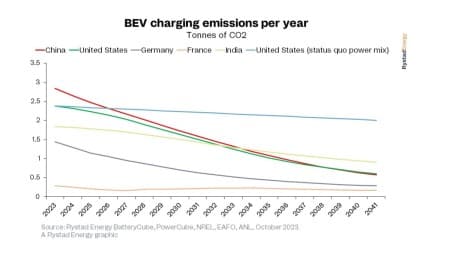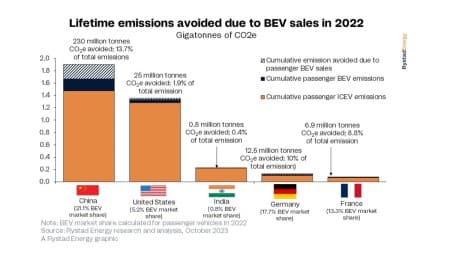Battery electric vehicles (BEV) are the clear winner when trying to reduce emissions in the transportation sector, according to Rystad Energy research. Despite incurring higher emissions in the manufacturing process of electric vehicles and an enduring reliance on fossil fuel power generation in many countries, the positive environmental impact of switching to a BEV over the vehicle’s lifetime is unmistakable.
Our analysis shows that battery-powered vehicles contribute at most half the carbon dioxide equivalent (CO2e) of diesel or gasoline cars across their lifecycle, regardless of the country of operation. Even in countries where the power grid is dominated by fossil fuels, battery-powered cars emit about 50% of the CO2e of an internal combustion engine (ICE) vehicle. As renewable sources replace coal and gas-fired generation, emissions related to the operation of BEVs could drop by 86%.
Our in-depth research of lifecycle BEV and ICE vehicle emissions considers every stage of the manufacturing process and the vehicle’s operation. This includes the manufacturing of the vehicle’s body, known as body in white (BIW), powertrain assembly, maintenance, fuel and electricity-related emissions, and battery production for BEVs. We are conscious that there are often societal and humanitarian impacts associated with EV manufacturing, battery production, and associated mining. However, this research is purely focused on the emissions comparison between battery electric and traditional-fuel vehicles.
Based on the current power generation mix in China, the lifecycle emissions of a BEV are about 39 tonnes of CO2e versus almost 85 tonnes for an ICE vehicle. The difference in the US is even starker. A BEV emits 42 tonnes of CO2e across its life in the US, 58% lower than a gasoline or diesel vehicle that emits more than 100 tonnes. Of these totals, emissions related to the extraction, refining, and burning of fossil fuels contribute about 90% of all ICE emissions. The breakdown of emissions across a battery-powered vehicle’s life is directly tied to its electricity consumption and how that power is generated.
Overall, battery electric vehicles are clearly the right technology to reduce emissions in the transportation sector. Switching to a BEV will reduce long-term emissions despite a larger environmental impact at the beginning of the vehicle's life. Contrary to some claims, electric car adoption is not a fool’s errand; it will slash emissions in the long run and accelerate the energy transition.
Abhishek Murali, senior clean tech analyst, Rystad Energy

Learn more with Rystad Energy’s Energy Transition Solution.
We selected five countries for our analysis – China, the US, India, Germany, and France – due to their diverse transportation factors like driving patterns, type of vehicle dominant in each country, and varying power mixes, both historical and forecast. Germany and France were chosen to reflect the European market in general and assess different power mixes, keeping other factors mostly similar. We used our base case power generation forecast for each country when evaluating lifecycle emissions to accurately reflect the evolving nature of electricity generation and its impact on BEV emissions. Each vehicle is expected to last 18 years, after which age most vehicles are scrapped.
Annual distance driven varies widely by country, with consumers in the US driving longer distances than every other country we studied. US vehicles travel on average about 23,000 kilometers (km) every year, compared to 19,000 km in China and about 13,500 km in Germany, France, and India. When forecasting emissions over the next 18 years, we predicted the evolution of driving distance based on historical data. Mileage in the US, China, and Europe is expected to fall about 1% annually based on official driving statistics and surveys, while distances driven in India are expected to increase by 0.5% per year as the country is still in the middle of its motorization period.
The power market holds the key
A country’s power mix will play a significant role in determining how quickly emissions reduction can be achieved when switching to BEVs. Whereas ICE vehicles become more emissions-heavy as they age, BEVs will emit less over the years as power generation becomes greener. For instance, in our base case scenario predicting the development of the US power grid, battery-powered cars will emit just 14% of the emissions equivalent from a gasoline or diesel car in 2041.
Stark contrasts can also be found in regions where most other factors are similar. Comparing Germany and France, the only deviation is in the emissions intensity of the grid. France, largely dominated by nuclear power, has about an 84% lower carbon intensity than Germany, which relies heavily on gas generation. Hence, emissions from charging an electric vehicle in France will be about 70% lower, resulting in around 37% lower lifecycle emissions.
Performing the same comparison for a coal-heavy power mix, in the case of India, results in 43% lower lifecycle emissions. Overall, adopting BEVs – even in a status quo power mix future – will be beneficial to the environment, especially in countries with high annual mileage like the US.

How much CO2 can electric vehicle sales displace?
Using this power-mix analysis, we can estimate the volume of emissions avoided through BEV sales, assuming driving distance is the same across both vehicle types. The average displacement factor varies widely by country depending on driving patterns and model availability. For instance, China has low annual average mileage and widespread BEV model availability, leading to an almost 1:1 emissions displacement factor. However, BEV adoption in the US can vary hugely from state to state. California has an almost 1:1 displacement factor, but the national average is estimated at 0.6. European countries have anywhere from a 0.8 to 1.1 displacement factor.
To illustrate this, 5 million passenger BEVs were sold in China in 2022, versus 17 million ICE cars. Assuming each of these BEVs emits 39 tonnes CO2e in its lifetime and an ICE emits 85 tonnes CO2e, ICE sales would emit 1.4 gigatonnes CO2e total, while the BEVs sold will add about 200 million tonnes of CO2e to the environment. However, if the same 5 million BEVs had been ICEs, added emissions would have been around 430 million tonnes CO2e. Thus, BEVs result in a lifecycle emissions reduction of 230 million tonnes CO2e – almost 14% of total passenger car emissions. A similar analysis in the US shows this figure at 25 million tonnes CO2e.

More Top Reads From Oilprice.com:
- OPEC+ Not Expected To Change Course On Oil Production Cuts
- The Geopolitical Forces Driving Today's Oil Market
- Top 10 Oil Titans Account For Over 70% of Global Production


















But it seems that the research hasn’t taken into consideration the following factors:
1- The emissions that are emitted during the disposing of the used BEV’s batteries.
2- Rises in electricity prices which far exceed those of gasoline and diesel.
3- Modern ICEs are far more technologically-advanced and environmentally-friendly than in the past. Their emissions have been drastically reduced.
4- Costs of the added electricity capacity needed to charge the supposedly millions of BEVs that on the roads. How would the added electricity capacity be sourced from: hydrocarbons, renewables or nuclear energy? Hydrocarbons primarily coal and natural gas account for 86% of global electricity generation compared with 11.7% for renewables. When we add emissions from the hydrocarbon-powered electricity generations and calculate the BEVs’ share of them, we find that emissions from BEVs are hardly different from ICEs.
The inclusion of the above factors in the research will change the results fundamentally.
Dr Mamdouh G Salameh
International Oil Economist
Global Energy Expert